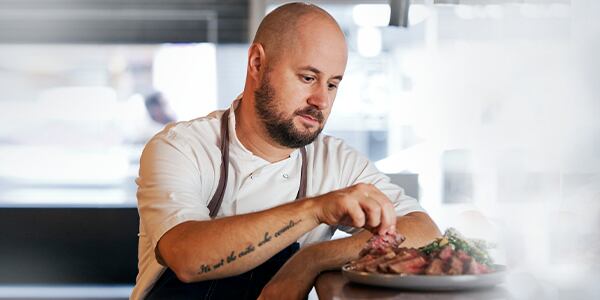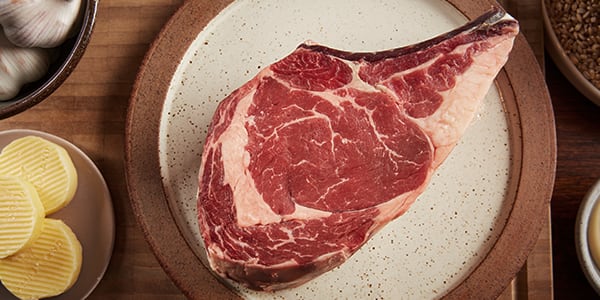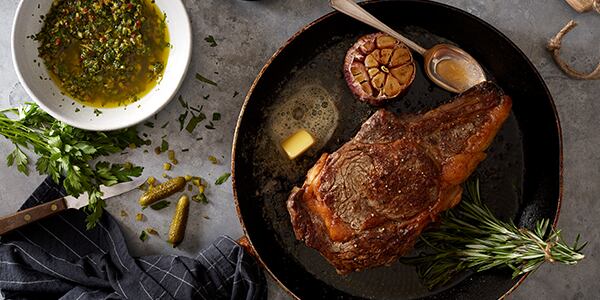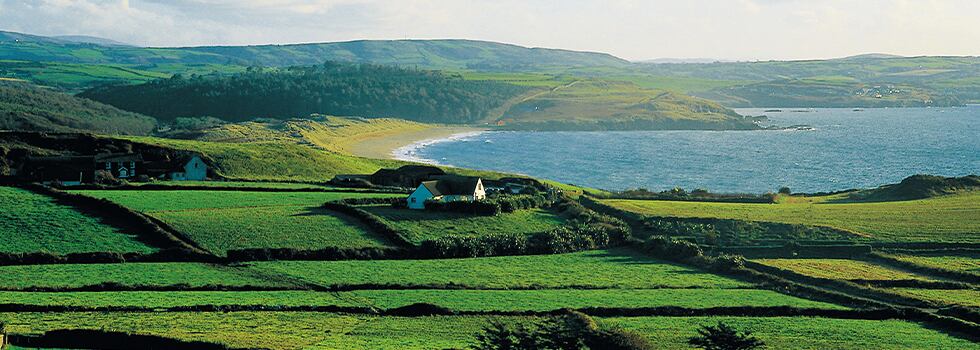Tom Cenci’s residency at Borough Market’s Stoney Street sees the former Duck & Waffle and Loyal Tavern chef get creative with locally sourced and sustainability driven ingredients, including grass-fed Irish beef.
Tom Cenci’s residency at Borough Market’s Stoney Street by 26 Grains is a tightly-run affair that has survived lockdowns, hastily-implemented restrictions and – more recently – one of the chilliest Aprils on record. Despite the cold snap coinciding with the reopening of hospitality for outdoor dining, the residency has been busy, so much so that it has now been extended until at least the end of the summer.
Created during the pandemic, the business is resilient thanks to keeping it simple: Tom runs the kitchen with just one other chef and has created an ingenious forward-thinking menu, that showcases quality local ingredients, with a focus on sustainability and reducing food waste. Tom is aiming to utilise every element from each ingredient he uses, from nose to tail cooking - using as much of the animal as possible, championing the unsung offcuts of beef such as onglet and featherblade. He goes a step further by recycling coffee grains into desserts and repurposing produce that would have otherwise been thrown away, while simultaneously putting top quality, sustainably produced, grass-fed Irish beef centre stage.

Tom has teamed up with Bord Bia (the Irish Food Board), to feature a rotating menu of grass-fed Irish beef centric dishes, using cuts from cattle that have been fed on a natural diet of grass, herbs and clovers, on the open pastures of nearby Ireland, providing a unique depth of flavour and sweetness to the beef.
“I have been using Irish grass-fed beef for over ten years now and it’s produce I’m really passionate about. I want to honour the ethos of 26 Grains, of using top class sustainable ingredients and for me, that’s what Irish beef embodies.”
“When I started the residency, I was keen to not just use the prime cuts, because everybody knows and loves a fillet or a bone-in rib eye, I wanted to champion the offcuts, to make a more sustainable menu and show how versatile beef can be. There are so many other good cuts away from just the ribs and fillets. Cuts like onglet, cheek, bavette, flat iron and featherblade might be classed as cheaper offal cuts, but when it comes to Irish beef the animals have been treated in the exact same way, as the prime cuts. From the grass-fed diet to exceptional animal husbandry by farmers in Ireland, where 99% of Irish farms are family owned and run, no matter the cut, Irish beef is always of a consistently high quality. The farmers truly have the health and welfare of their cattle and landscape at their heart, something which is very important to me,” explains Tom, who trained with Herbert Berger in London and with the late Joël Robuchon in Paris. More recently, Tom oversaw the kitchen at trendy skyscraper restaurant Duck & Waffle as executive chef before launching Loyal Tavern in 2019, which was sadly one of the many casualties of the pandemic.
Beyond the beef, Tom works closely with his other suppliers to identify top-notch yet unsung ingredients, a tactic that boosts the residency’s sustainability credentials as well as its bottom line.
“It’s often simply a case of calling them up and asking what they have a surplus of,” he advises. “For example, I take salmon bellies and salmon collars from a local smokehouse. They’re packed with flavour”
“It’s important we start to address food waste and sustainability. It's something that can't just be fixed overnight, but the more we can all do to help raise awareness the better.”
Another of Tom’s sourcing tricks is to seek out product that is not quite in good enough condition to sell at full price. Working with top-end fruit and vegetable specialist Natoora, he works magic with boxes of slightly bruised or going-out-of-date produce that other chefs might turn their noses up at.

Locally sourced beef you can trust
“Ireland has always been synonymous with lush green fields, fresh, clean air and plentiful rain. This is a key natural advantage that creates the perfect environment for rearing cattle and allows grass-based beef production to flourish across the island. In fact, grass-fed has always been Ireland’s production system. Irish beef farmers continue to work with care, commitment and respect for traditions, I have great appreciation for the farmers and the steps they go through,” continues Tom.
“What the cattle eat is so important. Near constant access to lush fields of grass, herbs and flowers imparts a really mature, beefy flavour,” he says. “It makes for incredible marbling too, there is a high degree of creaminess and yellowness all due to the grazed grass in their diet. Sometimes when you cut it open it’s just unbelievable. We’re really lucky to have such a beautiful product on our doorstep, I’m extremely proud to write Irish grass-fed beef on the menu.”
“I always get great feedback from my customers too – they comment on the taste, the texture, how it’s so tender. What I love about Irish beef is its consistency, every time I buy it, I can trust it is always going to be good. Over six and a half years at Duck & Waffle we never changed it on the menu once. Irish beef won blind taste tests every single time.”
Working with a duo of quality London butchers – the Barons Court-based HG Walter and the Bermondsey-based and therefore very local O’Shea’s – Tom has identified several cost-effective cuts that more than deliver in the flavour stakes.
“A close relationship with your butcher helps. I’d recommend going to visit them. It’s good to see the produce up close and understand the aging process and appreciate why some cuts fare better than others,” he advises. “While beef always benefits from some aging, it’s important to bear in mind that it becomes more expensive as it ages because it loses weight and butchers need to store it – they need to get that cash back.”
Sourcing less obvious cuts of meat and cooking them with skill makes sense at all levels, but it is an especially useful tactic for chefs that have a desire to work with the very best quality meat, while still keeping menu prices accessible. “Offcuts and lesser-known cuts do not mean ‘not good’. If the produce is good then it’s going to be good,” says Tom. “These better value cuts often deliver better flavour because they tend to come from parts of the animal that are fattier or have done more work. When you combine this with an animal that has led a healthy and happy life, as is the case with Irish grass-fed beef, the results are simply fantastic.”

Creative-yet-accessible cooking
A case in point is Tom’s grass-fed Irish featherblade, which is served with spätzli, wild garlic and Belper Knolle, a pepper-encrusted Swiss cheese that is shaved at table just like a black truffle. It’s a knockout of a dish that plays around with the notion of pasta with meat sauce and one that is emblematic of Tom’s creative-yet-accessible approach to food.
“It’s baffling to me that featherblade is not seen on menus more regularly,” he says. “It takes its name from the tough sinew that runs through it. You need to break it down through slow cooking, but it’s worth the wait.”
Tom colours the featherblade aggressively before cooking very gently for four or five hours in a mixture of stock, red wine, vegetables and herbs. A crucial step that’s often missed with this sort of preparation is to let the meat cool in its braising liquor, so it reabsorbs some of the juices. Once the meat is completely cooled, the liquid is strained before being reduced to a heavy broth.
During service, the dish is simplicity itself to serve with the featherblade reheated with its sauce and the pre-cooked spätzli pan-fried briefly in beef fat obtained by rendering offcuts. “We actually use beef fat in place of oil for most of our pan frying. It’s free and imparts a great beefy flavour,” says Tom.
Though not on the menu right now, other good value cuts that Tom has championed at Stoney Street include brisket and onglet, both highly flavoursome cuts that in the hands of a skilled chef can be rendered perfectly tender.
“Offering great value is essential for us now, and in all honesty it’s hard to be perceived to be doing that if you’re offering the very premium cuts because they’re always going to have a high menu price,” he says.
“Frankly right now it’s about survival, staying relevant and offering our customers a great experience at an affordable price, with local and sustainable ingredients. This period has not been easy, but we’re feeling positive about the summer.”




